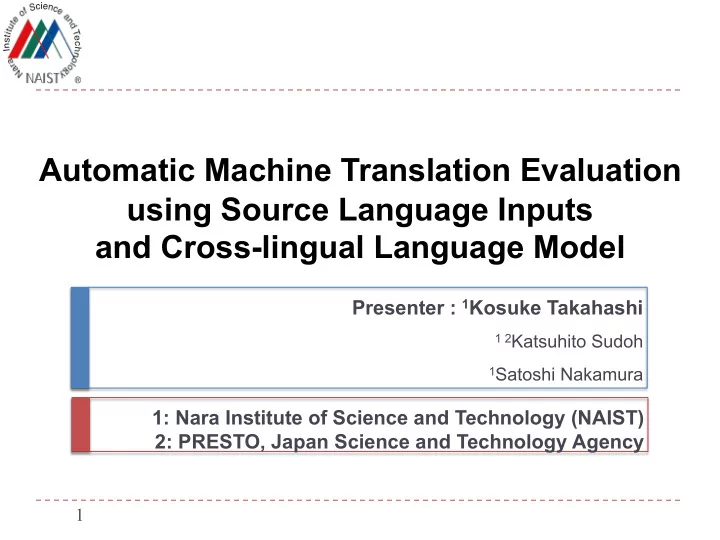

Automatic Machine Translation Evaluation using Source Language Inputs and Cross-lingual Language Model Presenter : 1 Kosuke Takahashi 1 2 Katsuhito Sudoh 1 Satoshi Nakamura 1: Nara Institute of Science and Technology (NAIST) 2: PRESTO, Japan Science and Technology Agency 1
Existing metrics based on surface level features } BLEU[Papineni +, 2002], NIST[Doddington +, 2002], METEOR[Satanjeev + , 2005] } Calculate evaluation scores with word matching rate Problems: Relying on lexical features → cannot appropriately evaluate semantic and syntactic differences 2
Existing metrics based on embedded representation } RUSE[Shimanaka +, 2018], BERT regressor[Shimanaka +, 2019] } Fully parameterized metrics } Use sentence vectors } fine-tuned to predict human evaluation scores } BERT regressor achieved the SOTA result on WMT17 metrics task in 2019 These metrics provide better evaluation performance than surface level ones. 3
Proposed multi-reference Conventional multi-reference Proposed Idea source reference 1 sentence system (reference 1) system translation reference 2 translation (hypothesis) (hypothesis) reference sentence reference n (reference 2) ○ better evaluation ○ better evaluation × costly to prepare multiple ○ a little cost to prepare 2 reference sentences references for each hypothesis 4
Architectures of a baseline and proposed models hyp+src/hyp+ref hyp+src+ref Baseline: BERT regressor evaluation ev on scor ore hyp+ref ev evaluation on scor ore evaluation ev on ML MLP scor ore ML MLP con oncaten enation on MLP ML v hy , v hy hyp+s +src, hyp+r +ref sen enten ence-pair vec ector or sen enten ence-pa pair r v hy sen enten ence-pai air r sen enten ence-pai air r hyp+src+ref vec ector or v hy vec ector or v hy vec ector or v hy hyp+r +ref hyp+src hyp+r +ref sentence-pair encoder sentence-pair encoder sentence-pair encoder hypot othes esis + sou ource e hypot othes esis + hypot othes esis + hypot othes esis + ref efer eren ence + ref efer eren ence sou ource ref efer eren ence 5
The setting of experiments • Language model : mBERT, XLM15 • Input : hyp+src/ref, hyp+src+ref, hyp+ref, hyp+src • Baselines : SentBLEU, BERT regressor (BERT with hyp+ref) • Data : WMT17 metrics shared task • Language pairs : {De, Ru, Tr, Zh}-En 6
Results : comparison with baselines metric or language model input style average score (r) SentBLEU hyp, ref 48.4 BERT regressor hyp+ref 74.0 (monolingual BERT) hyp+src/hyp+ref 72.6 + + 3. 3.1 mBERT hyp+src+ref 68.9 hyp+src/hyp+ref 77.1 XLM15 hyp+src+ref 74.7 • Proposed XLM15 with hyp+src/hyp+ref surpassed basline scores 7
Results : evaluation performance for each input style language model input style average score (r) hyp+ref 67.9 hyp+src 55.9 + + 4. 4.7 mBERT hyp+src/hyp+ref 72.6 72. hyp+src+ref 68.9 hyp+ref 74.1 hyp+src 72.8 + 3. + 3.0 XLM15 hyp+src/hyp+ref 77.1 77. hyp+src+ref 74.7 • Using src and ref improve evaluation performance • hyp+src/hyp+ref was the best input style 8
Analysis : scatter plots of evaluation and DA scores XLM15 hyp+src/ref Pearson’s correlation score All : 0. 0.768 768 DA ≧ 0.0 : 0. 0.580 580 DA < 0.0 : 0. 0.529 529 Low quality translation is hard to evaluate Note: DA (Direct Assessment) is a human evaluation score 9
Analysis : The drop rate of Pearson’s correlation score from high DA to low DA range language model input style reduction rate (%) BERT regressor hyp+ref 16.10 (monolingual BERT) hyp+ref 22.05 – 14. 14.28 28 hyp+src 6.88 mBERT hyp+src/hyp+ref 7.77 hyp+src+ref 17.51 hyp+ref 14.20 – 5. 5.52 52 hyp+src 8.46 XLM15 hyp+src/hyp+ref 8.68 hyp+src+ref 11.12 Note: reduction rate indicates how much evaluation performance is degraded from high to low quality translations 10
Summary } Proposed a MT evaluation metric that utilizes source sentences as pseudo references } hyp+src/hyp+ref makes good use of source sentences and is confirmed to improve evaluation performance. } XLM15 hyp+src/hyp+ref showed the higher correlation with humans than baselines } Source information is contributed to stabilize the evaluation of low quality translations Future Work } Experiment with multiple language models and datasets } Focus on a better evaluation of low quality translations 11
Recommend
More recommend